Share
Finance and Economics Discussion Series: Expectations of Risk and Return Among Household Investors: Are Their Sharpe Ratios Countercyclical
United States Federal Reserve Board
(Author)
·
Gene Amromin
(Author)
·
Steven A. Sharpe
(Author)
·
Bibliogov
· Paperback
Finance and Economics Discussion Series: Expectations of Risk and Return Among Household Investors: Are Their Sharpe Ratios Countercyclical - United States Federal Reserve Board ; Amromin, Gene ; Sharpe, Steven A.
Choose the list to add your product or create one New List
✓ Product added successfully to the Wishlist.
Go to My Wishlists
Origin: U.S.A.
(Import costs included in the price)
It will be shipped from our warehouse between
Friday, July 19 and
Friday, July 26.
You will receive it anywhere in United Kingdom between 1 and 3 business days after shipment.
Synopsis "Finance and Economics Discussion Series: Expectations of Risk and Return Among Household Investors: Are Their Sharpe Ratios Countercyclical"
Data obtained from special questions on the Michigan Survey of Consumer Attitudes over several years are used to analyze stock market beliefs and portfolio choices of household investors. Consistent with other survey results, expected future returns appear to be extrapolated from past realized returns. The data also indicate that expected risk and return are strongly influenced by economic prospects. When investors believe macroeconomic conditions are more expansionary, they tend to expect both higher returns and lower volatility, which implies that household Sharpe ratios are procyclical. Separately, perceived risk in equity returns is found to be strongly influenced by household investor characteristics, consistent with documented behavioral biases. These expectations reported by respondents are given credence by the finding that the proportion of equity holdings in respondent portfolios tends to be higher for those who report higher expected returns and lower uncertainty. Finally, the finding of procyclical expected returns holds up when we instead condition on conventional business cycle proxies such as the dividend yield and CAY, which yields a stark contrast with the inferences from studies based on actual returns.
- 0% (0)
- 0% (0)
- 0% (0)
- 0% (0)
- 0% (0)
All books in our catalog are Original.
The book is written in English.
The binding of this edition is Paperback.
✓ Producto agregado correctamente al carro, Ir a Pagar.

